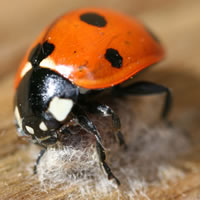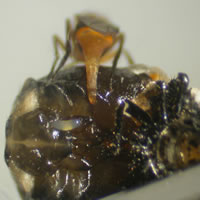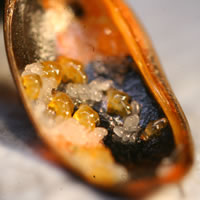The bright colours of many ladybirds are to warn potential predators of their distastefulness (aposematism). They exude a yellow substance (reflex blood) when attacked which is rich in toxic alkaloids. Despite this, ladybirds do have some natural enemies.
Records needed of ladybirds affected by natural enemies
If you have records or photographs of ladybirds affected by any of the enemies below, we would be very pleased to see them. Please email ladybird-survey@ceh.ac.uk

Predators
Some birds which feed on the wing, such as swifts and swallows, are immune to the defensive chemicals of ladybirds. Ladybirds are also attacked and eaten by some spiders, some of the larger predatory beetles and true bugs (Hemiptera), and their eggs and larvae occasionally fall prey to other species of ladybird and to lacewing larvae.
Parasitoid wasps and flies
Several species of wasp and true fly lay their eggs on or inside ladybird larvae, pupae or adults. When the eggs hatch, the larvae of these parasitoids feed inside their ladybird host, exiting when fully-fed to pupate and emerge as adults outside the ladybird, which dies as a result. These parasitoids include the wasp Dinocampus coccinellae (Braconidae) - see picture, at least two species of scuttle-fly (Phoridae),

and a tachinid fly.
Mites
Some mite species affect ladybirds, including sexually transmitted mites in the genus Coccipolipus, which cause sterility in some ladybirds.
Pathogenic fungi
The soil dwelling fungus Beauveria bassiana is pathogenic to some ladybirds species. The fungus produces infective spores which germinate and then penetrate through the insect cuticle. This fungus then proliferates within the host until it has utilised all available host resources at which stage it erupts back through the host cuticle and produces more infective spores. Fungi in the genus Laboulbeniales also affect some ladybirds.

Male-killing bacteria
Some female ladybirds (including harlequins) are infected with a male-killing bacterium (Spiroplasma), which kills male but not female embryos. This male-killing causes an imbalance in population sex ratios in some parts of Asia. Work is currently in progress to find out whether any of the harlequins that have arrived in Britain are infected with this sex ratio distorter.
